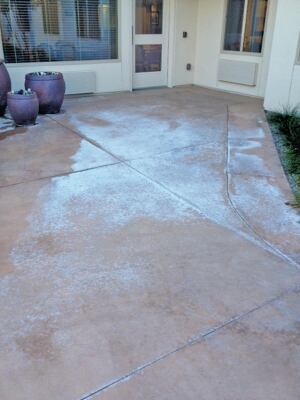QUESTION: We have an integral-colored concrete slab just over a year old in an outside courtyard that has become discolored with a white stain or substance on the surface. We have tried removing the substance by applying vinegar water and pressure-washing without success. What is the white substance and what caused it? How do we remove it?
ANSWER: The white substance is efflorescence (which means “to flower out” in French). Usually white in color, efflorescence is a discoloration caused by crystalline deposits of salts on concrete surfaces. These deposits often contain compounds such as calcium, sodium and potassium hydroxides or carbonates, bicarbonates, chlorides, and sulfates of calcium and magnesium. These substances typically originate as soluble compounds within the concrete that are transported and deposited on the surface by upward moisture migration and evaporation. Sometimes, they originate in the underlying soil where they are carried by moisture upward through the concrete and deposited on the surface.
Water is the solvent and vehicle for transporting the soluble salts to the surface. While not harmful, it is unsightly, especially on integral-colored concrete. Efflorescence can form a thick layer on the surface, which can completely hide the concrete’s color or, as in your case, create unsightly white patches.
Causes
Usually, efflorescence is primarily composed of calcium carbonate formed when leached calcium hydroxide (CH) from within the concrete reacts with carbon dioxide in the atmosphere. CH is one of the hydration products created by the chemical reaction between portland cement and water. It is readily soluble in water and easily leached.
During initial drying, excess mix water saturated with CH migrates to the surface of the concrete where it evaporates, leaving the CH. The deposited CH then reacts with carbon dioxide to form water-insoluble calcium carbonate. CH only remains water soluble for a brief period after exposure to the atmosphere. The efflorescence that forms during initial concrete drying or soon after concrete placement is called primary or new efflorescence.
Formation of primary efflorescence is strongly affected by weather conditions such as ambient temperatures, humidity, and wind. During high rates of surface evaporation, small amounts of soluble salts are brought to the surface, which reduces the risk of efflorescence. Occurrences are greater during cool and wet weather followed by a dry and warm period. Slow and extended evaporation periods allow more soluble salts to migrate to the surface, which increases the potential and severity of efflorescence. Therefore, proper concrete curing is essential to minimize surface evaporation, even during periods of cold and wet weather.
After initial drying, secondary efflorescence can occur if the concrete is exposed to alternate wetting and drying, or to a moisture source beneath the concrete that allows or promotes soluble salts to be leached out of the concrete.
How to remove efflorescence
Try to wash and scrub off the white deposits using clean water as soon as they appear. This may work if the CH deposits have not fully reacted with carbon dioxide in the atmosphere and become insoluble. Be sure to remove any ponded water; otherwise, efflorescence may reoccur.
For your project, you will need a mild or diluted acidic solution that is stronger than vinegar water. For gray concrete, the following solutions are recommended:
- One part hydrochloric acid (muriatic) in 10 to 20 parts water (10 percent to 5 percent concentration);
- One part phosphoric acid in 10 parts water;
- One part phosphoric acid, plus one part acetic acid in 20 parts water;
- Prepackaged/proprietary efflorescence removers.
However, more diluted solutions are recommended for integral-colored concrete to avoid surface etching that may reveal aggregates and change the color and texture of the surface. Start with one part hydrochloric acid in 50 or 100 parts of water (2 percent to 1 percent concentration) and increase the concentration as needed.
Before using the acidic solution, flood the surface with clean water to prevent the acid from being absorbed into the concrete. Allow the acidic solution to set three to five minutes before scouring off the efflorescence with a stiff brush. Immediately and thoroughly flush the surface with clean water to remove all acid. Apply the solution uniformly in terms of concentration, amount, and duration. Protect surfaces that can be damaged by acid and treat the entire slab to achieve a uniform color and texture.
Always perform a trial treatment on an inconspicuous area to check for adverse effects and to perfect the technique. Read the Material Safety Data Sheets to be aware of the hazards associated with the acid. After removing the efflorescence, consider sealing the surface with an exterior concrete sealer.
Written by Kim Basham, PhD, PE, FACI, and president of KB Engineering, who specializes in concrete construction, troubleshooting, nondestructive testing, forensics, and repair. E-mail [email protected].










